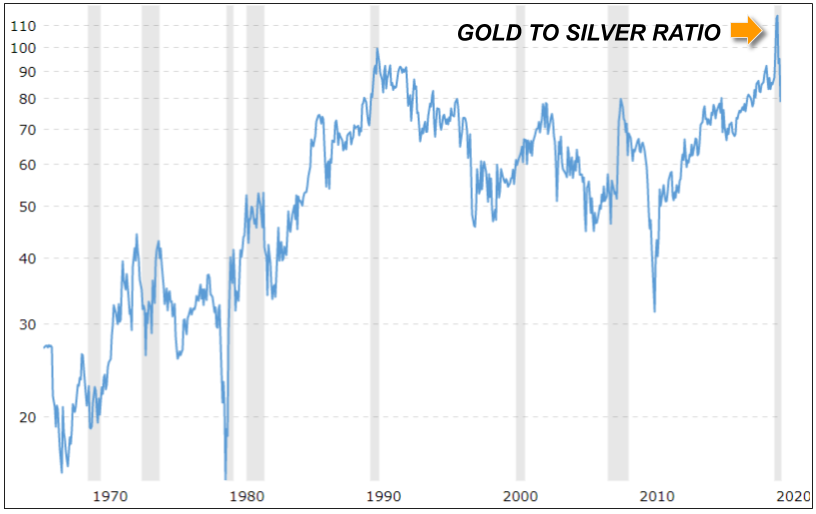Why Silver is Taking Off Like a Rocket Ship — and Should Keep Going
In TradeSmith Decoder, we nailed the 2020 silver move thus far.
And it looks like there is much more to come.
We took a super-sized position in a bellwether silver ETF on March 23, two days after the low. Then we added a second leg (again substantially sized) on July 9, noting the upside move could accelerate.
In addition to that, TradeSmith Decoder picked up substantial exposure to silver equities, and published a special report titled “The Triple-Bullish Case for Silver Stocks.” (If you don’t already have access to Decoder analysis and special reports, reach out to our Dedicated Sales team at 866-220-1107.)
This week, silver took off like a rocket ship, breaking out to multi-year highs, in a near-vertical move, on larger trading volume than silver has seen in years.
The best part, in our view, is that silver is just getting warmed up here. This silver move is no flash-in-the-pan mania move or short-term speculative blip.
It is the beginning of an incredibly powerful trend that could play out over the course of years.
Silver is sometimes referred to as “the poor man’s gold.” There are multiple reasons why the nickname sticks around. Silver, per ounce, is less expensive than gold. For much of financial history, silver was a monetary alternative to gold. And the silver price tends to follow the gold price.
Silver could also be considered a “high-beta sibling” of gold. By that meaning, silver is like gold with higher volatility (for better and for worse).
This makes sense because the silver market is of substantially smaller size than the gold market, which means capital flowing into silver generates more bang for the buck.
Silver is also an industrial metal. Unlike gold, which is hard to extract from the earth and never gets used up, silver is relatively easier to abstract (often as a byproduct of copper, lead, or zinc) and gets consumed by industrial processes.
The industrial metal angle is a double-edged sword for silver.
On the one hand, the relative ease of mining silver (compared to gold) means the stock-to-flow ratio for silver is more like a normal commodity than gold-like (whose stock-to-flow ratio is extremely low) or Bitcoin-like (where the stock-to-flow ratio will eventually hit zero).
But on the other hand, stepped-up industrial demand for silver can be like rocket fuel for the silver price.
And when you get a powerful uptrend in gold (helpful to silver on the precious metals side) combined with a sustainable increase in end-use demand (helpful to silver on the industrial side) both occurring at the same time, watch out. That’s when the silver price can head for the stratosphere.
And that exact scenario — a big, new gold bull market, combined with rising industrial demand — is exactly what is playing out right now.
Did you know, for example, that silver is a significant component of solar panels?
“Silver, already at a six-year high amid rising haven demand and tight supply, may be poised for a big additional boost from a less-well-known driver,” Bloomberg reports. “The metal used in solar panels stands to gain as governments looking to jump-start economic growth and slow climate change pour more money into clean energy technologies…”
“It is this push into solar photovoltaics that is crucial for future silver demand,” says Colin Hamilton, the managing director for commodities research at BMO Capital Markets. “More than $50 billion of green stimulus has been approved by governments thus far this year. But perhaps more impactful has been the recent Biden campaign clean energy plan.”
Some have wondered if the big move in silver stocks — some of the names in the TradeSmith Decoder are leaping higher by 5% and 10% at a time — is being driven by Robinhood traders, the way they drove the crazy moves in stocks like Hertz (HTZ), Nio (NIO), and Nikola (NKLA).
We say no — the silver move is real. The drivers are mammoth and sustainable and clear to see.
On the precious metals side, we are seeing the slow-motion destruction of the dollar in real time via unprecedented fiscal and monetary stimulus actions (a subject covered at length in TradeSmith Daily).
And on the industrial side, silver demand will not only tap into a general renaissance of government-sponsored public works projects (a politician near you will be channeling FDR), it gets a direct turbo-charge via silver’s use in photovoltaics.
When trillions of dollars pour into “Green New Deal” type projects, and save-the-earth, progressive-type policies ramp up an aggressive roll-out of solar energy projects — even as the competitive economics of solar power start beating out fossil fuels — guess which industrial metal gets juice from all that? Silver.
Then, too, the Gold to Silver Ratio — a ratio of how expensive gold is compared to silver — recently hit its highest level in a hundred-plus years!
You can see the outlier nature of the move in the chart below, via macrotrends.net, which shows the Gold to Silver Ratio dating back to 1966.

In the months of May and June, the Gold to Silver Ratio began to mean revert, moving in the direction of its long-term historical average.
In order to mean revert further, one of two things will have to happen: Either the price of gold will have to decline (more so than silver), or the silver price will have to keep rising (at a faster pace than gold).
Given how the Federal Reserve is all but trashing the U.S. dollar in real time — even as politicians on multiple continents plan huge green energy initiatives (which means an explosion in solar-based silver demand) — we see it as obvious which outcome is more likely.